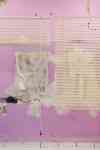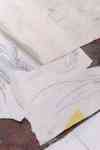
The process of waiting has an inbuilt uneasiness to it. Time loses its flow in a tight and dreary waiting room. People are warily studying each other, or languidly swiping their screens.
The waiters share a common existence for a brief while, and become tied by the absurdity and boredom of the situation, in a unique way that creates a microcosm of the society. As all the elements of the aches and stresses are waiting to be remedied, the room provides a potential for a Kafkaesque scene, where the familiar way of navigating through existence starts to decompose.
The impossibility to keep all the accumulated emotions and existential experience in the confines of a human body results in organic forms in Corinna Helenelund’s (b. 1985, Finland) work. Enclosing surfaces get absorbed and swallowed by her soft sculptural installations, through which different levels of pain are studied. In this anatomy lesson, pain and stress can be distinguished based on their organic forms and colors and understood also through the notions of gravity, weight, and volume.
In the search of releasing strong or repressed emotions, comfort and consolation are sought in activities that allow people to journey somewhere else. Lola Mercier (b. 1989, France) works with rudimentary forms and a retro Californian palette, which originate from the artist’s travel documentation. Instagram pictures with their standard format have turned into illustrations, which get another layer through the process of weaving: daydream landscapes linger somewhere between personal fantasies and collective unconsciousness.
In the photography of Henry Roy (b. 1963, Haiti), every picture carries its own energy, simultaneously aiming to re-establish a sensation, feeling, recollection of the past. He captures dream-like landscapes, which seem almost impossible to point to any certain location or moment in time. The warmth and languor of his works transport us to a non-descript state, where poised observation can yield golden moments.
Ultimately, the only way to tolerate the process of waiting is through its direct confrontation, which allows us to bypass the notion of time. In Sara de la Villejegu ’s (b. 1985, France) work, a trace of every confrontation between the artist and her work can be read in the pieces and their organic substance: the meaning of these encounters can also be read in the space. Tangibility takes all the importance, and simultaneously the process of waiting has undergone a rupture.
Experimental textiles made by Thompson Street Studio, founded by Susan Cianciolo (b. 1969, US) and Kiva Motnyk (b. 1978, US) carry the same idea: finding beauty in already existing things and materials. Transforming the ancient craft of quilting and patchwork to modern flair is a work of patience and meditation, and brings a whole new meaning to time. Slowly but surely, the work takes its form, and finally, waiting can turn into an opportunity to transform into something less personal and intimate, to be able to go beyond the process of waiting, and ultimately the notion of time.




















